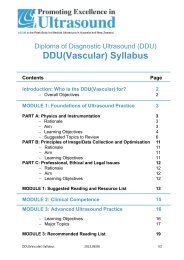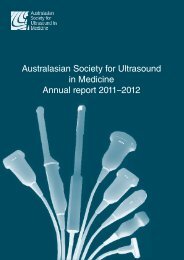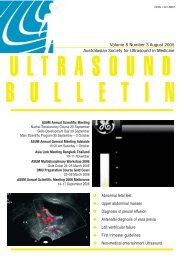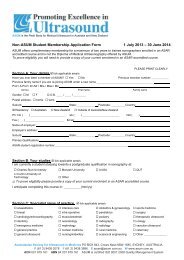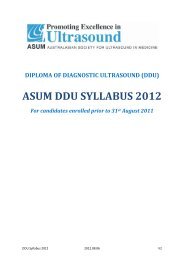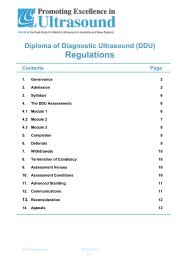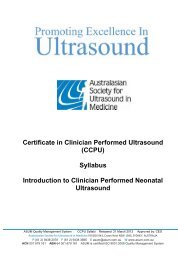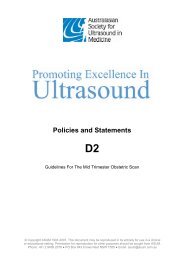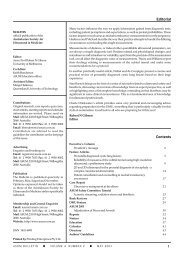Volume 6 Issue 3 - Australasian Society for Ultrasound in Medicine
Volume 6 Issue 3 - Australasian Society for Ultrasound in Medicine
Volume 6 Issue 3 - Australasian Society for Ultrasound in Medicine
- No tags were found...
Create successful ePaper yourself
Turn your PDF publications into a flip-book with our unique Google optimized e-Paper software.
<strong>Ultrasound</strong> evaluation of neck lymph nodes<br />
echogenicity of the lymph nodes may help the<br />
differentiation, as metastatic nodes from medullary<br />
carc<strong>in</strong>oma of the thyroid are hypoechoic, whereas metastatic<br />
nodes from papillary carc<strong>in</strong>oma of the thyroid are<br />
hyperechoic. The relatively high <strong>in</strong>cidence of calcification<br />
<strong>in</strong> metastatic nodes from papillary carc<strong>in</strong>oma of the thyroid<br />
makes this feature useful <strong>for</strong> the diagnosis.<br />
Calcification may also be found <strong>in</strong> lymph nodes, <strong>in</strong>clud<strong>in</strong>g<br />
lymphomatous and tuberculous nodes, after treatment.<br />
However, the calcification <strong>in</strong> these nodes is usually dense<br />
and shows acoustic shadow<strong>in</strong>g.<br />
Intranodal necrosis<br />
Lymph nodes with <strong>in</strong>tranodal necrosis, regardless of their<br />
size, are pathologic 4 . Intranodal necrosis can be classified<br />
<strong>in</strong>to two types: cystic necrosis (also known as liquefaction<br />
necrosis) and coagulation necrosis. Cystic necrosis appears<br />
as an echolucent area with<strong>in</strong> the lymph nodes (Figure 10),<br />
whilst coagulation necrosis is an uncommon sign and<br />
appears as an echogenic focus with<strong>in</strong> the nodes 30-32 .<br />
Figure 11 Transverse sonogram of a tuberculous node (arrows).<br />
Note the adjacent soft tissues edema which appears<br />
heterogeneous and hypoechoic with loss of fascial planes<br />
(arrowheads).<br />
Figure 10 Transverse sonogram show<strong>in</strong>g a metastatic node<br />
with <strong>in</strong>tranodal cystic necrosis (arrows).<br />
Intranodal necrosis may be found <strong>in</strong> malignant and<br />
<strong>in</strong>flammatory nodes, with cystic necrosis more common<br />
than coagulation necrosis. Cystic necrosis is common <strong>in</strong><br />
tuberculous nodes 20, 21 , and metastatic nodes from squamous<br />
cell carc<strong>in</strong>omas 4 and papillary carc<strong>in</strong>oma of the thyroid 4, 37 .<br />
Lymphomatous nodes seldom show cystic necrosis unless<br />
the patient has previous radiation therapy or chemotherapy,<br />
or has advanced disease 5, 40 .<br />
Adjacent soft tissues edema<br />
Granulomatous and metastatic nodes can <strong>in</strong>vade the<br />
surround<strong>in</strong>g soft tissues and cause edema or <strong>in</strong>duration 20, 40 .<br />
On ultrasound, the soft tissues edema is identified by diffuse<br />
hypoechogenicity with loss of fascial planes (Figure 11). It<br />
has been reported that adjacent soft tissues edema is<br />
common <strong>in</strong> tuberculous lymphadenitis (43% - 49%) 20, 21 .<br />
There<strong>for</strong>e, it is a useful feature <strong>for</strong> diagnos<strong>in</strong>g tuberculosis.<br />
However, soft tissue edema may also be found <strong>in</strong> patients<br />
with previous radiation therapy of the neck 25 .<br />
Matt<strong>in</strong>g<br />
Matt<strong>in</strong>g is considered as clumps of multiple abnormal nodes<br />
with no normal <strong>in</strong>terven<strong>in</strong>g soft tissues (Figure 12), and it is<br />
Figure 12 Sonogram show<strong>in</strong>g matt<strong>in</strong>g of multiple tuberculous<br />
nodes.<br />
a common feature <strong>in</strong> tuberculous lymphadenitis (59% -<br />
64%) 20, 21 . The high <strong>in</strong>cidence of matt<strong>in</strong>g <strong>in</strong> tuberculous nodes<br />
is considered to be the result of periadenitis and adjacent<br />
soft tissues edema. S<strong>in</strong>ce matt<strong>in</strong>g of lymph nodes is common<br />
<strong>in</strong> tuberculous lymphadenitis, it is a useful feature to<br />
differentiate tuberculosis from other diseases.<br />
Vascular pattern<br />
It has been reported that the evaluation of the vascular<br />
pattern of normal and abnormal cervical lymph nodes is<br />
highly reliable, with a repeatability of 85% 41 . Small normal<br />
lymph nodes (maximum transverse diameter < 5 mm)<br />
usually do not show vascular signals as the blood vessels<br />
are too small to be detected. Approximately 90% of normal<br />
lymph nodes with a maximum transverse diameter greater<br />
than 5 mm present with hilar vascularity 33 . Normal and<br />
reactive lymph nodes usually present with hilar vascularity,<br />
or may seem to be apparently avascular 42-45 .<br />
Peripheral or mixed vascularity are common <strong>in</strong> metastatic<br />
nodes 42-44, 46, 47 . There<strong>for</strong>e, the presence of peripheral vessels<br />
<strong>in</strong> lymph nodes is highly suspicious of malignancy. The<br />
peripheral vascularity <strong>in</strong> metastatic nodes is related to<br />
tumour <strong>in</strong>filtration of the lymph nodes <strong>in</strong> which the tumour<br />
14 ASUM ULTRASOUND BULLETIN VOLUME 6 NUMBER 3 AUGUST 2003




